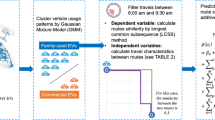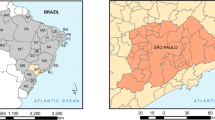Abstract
Investigating travel time distribution and associated variability is important for a variety of transport planning, traffic management, and control projects. Studies that investigated travel time distribution tend to be limited to explore changes in characteristics of distribution with respect to space and time of day. Given the availability of big dataset that contains seven different types of vehicle trajectories in the city of Athens for around 56,000 trips which are traversing on more than 1.8 million road links, this study presents the detailed investigation of travel time distribution in different spatiotemporal settings. The study considered four different types of urban roads and six time intervals along with consideration of weekdays and weekends. The empirical investigation employed Kruskal-Wallis, Chi-square, and Kolmogorov-Smirnov tests to fit travel time data into seven unimodal statistical distributions that are found in the literature to describe travel time distribution. It is found that lognormal distribution outperformed other distribution, and all of the considered categories of travel time data are well-fitted to this distribution. Additionally, parameters of lognormal distribution for different categories of travel time data are not significantly different from each other, which led to the conclusion that travel time distribution is roughly independent of space and time, which is in agreement with a few earlier studies that are limited in their scope especially in relation with availability of data. With this important finding, this study estimate values of travel time variability for different classes of individuals employing a standard approach that requires time of day independent standardized distribution of travel time. It is estimated that for Athens population value of travel time variability is approximately half of the value of travel time. This is useful to carry out cost-benefit analyses for mobility-related projects in Athens, Greece.


Similar content being viewed by others
References
Adnan M, Watling DP, Fowkes AS (2009) Model for integrating home-work tour scheduling with time-varying network congestion and marginal utility profiles for home and work activities, Transportation Research Record-Journal of Transportation Research Board, No. 2134, pp:21–30
Arezoumandi M (2011) Estimation of travel time reliability for freeways using mean and standard deviation of travel time. J Transport Syst EngInf Technol 11(6):74–84
Batterman S, Cook R, Justin T (2015) Temporal variation of traffic on highways and the development of accurate temporal allocation factors for air pollution analyses. Atmos Environ 107:351–363
Baqueri SFA, Adnan M, Kochan B, Bellemans T (2019) Activity-based model for medium-sized cities considering external activity–travel: enhancing FEATHERS framework. Futur Gener Comput Syst 96:51–63
Beaud M, Blayac T, Stéphan M (2016) The impact of travel time variability and travelers’ risk attitudes on the values of time and reliability. Transp Res B Methodol 93:207–224
Chen A, Zhou Z (2010) The α-reliable mean-excess traffic equilibrium model with stochastic travel times. Transp Res B Methodol 44(4):493–513
Chen P, Tong R, Lu G, Wang Y (2018) Exploring travel time distribution and variability patterns using probe vehicle data: case study in Beijing. J Adv Transp. https://doi.org/10.1155/2018/3747632
Chen P, Yin K, Sun J (2014) Application of finite mixture of regression model with varying mixing probabilities to estimation of urban arterial travel times, Transportation Research Record. No. 2442:96–105
Eliasson J (2019) Modeling reliability benefits. Transport Findings. https://doi.org/10.32866/7542
Emam EB, Al-Deek H (2006) Using real-life dual-loop detector data to develop new methodology for estimating freeway travel time reliability. Transportation Research Record 2006(1959):140–150
Fosgerau M (2017) "the valuation of travel-time variability", in quantifying the socio-economic benefits of transport. OECD Publishing, Paris. https://doi.org/10.1787/9789282108093-3-en
Fosgerau M, Fukuda D (2012) Valuing travel time variability: characteristics of the travel time distribution on an urban road. Transportation Res Part C: Em Technol 24:83–101
Fosgerau M, Karlström A (2010) The value of reliability. Transp Res B Methodol 44(1):38–49
Guo F, Rakha H, Park S (2010) Multistate model for travel time reliability. Transportation Research Record, Journal of Transportation Research Board, No 2188:46–54
Jenelius E (2012) The value of travel time variability with trip chains, flexible scheduling and correlated travel times. Transp Res B Methodol 46:762–780
Kaparias I, Bell MGH, Belzner H (2008) A new measure of travel time reliability for in-vehicle navigation systems. Journal of Intelligent Transportation System 12(4):202–211
Kazagli, E., Koutsopoulos, H.N., 2012. Estimation of arterial travel time from automatic number plate recognition data. Transportation Research Record, Journal of Transportation Research Board 2391:22–31
Kieu L-M, Bhaskar A, Chung E (2015) Public transport travel-time variability definitions and monitoring. J Transp Eng 141:1. https://doi.org/10.1061/(ASCE)TE.1943-5436.0000724
Kuhn B, Higgins L, Nelson A, Finley M, Ullman G, Chrysler S, Wunderlich K, Shah V, Dudek C (2013) Effectiveness of different approaches to disseminating traveler information on travel time reliability. No. SHRP 2 reliability project L14
Lei F, Wang Y, Lu G, Sun J (2014) A travel time reliability model of urban expressways with varying levels of service. Transportation Research Part C: Emerging Technologies 48:453–467
Malleson N, Vanky A, Hashemian B, Santi P, Verma SK, Courtney TK, Ratti C (2018) The characteristics of asymmetric pedestrian behavior: a preliminary study using passive smartphone location data. Transaction in GIS 22(2):616–634
Ma Z, Koutsopoulos HN, Ferreira L, Mesbah M (2017) Estimation of trip travel time distribution using a generalized Markov chain approach. Transportation Research Part C: Emerging Technologies 74:1–21
McHugh ML (2013) The chi-square test of independence. Biochemia Medica 23(2):143–149
McKight PE, Najab J (2010) Kruskal-wallis test. The corsini encyclopedia of psychology:1–1
Newson P, Krumm J (2009) Hidden Markov map matching through noise and sparseness. In: Proceedings of the 17th ACM SIGSPATIAL international conference on advances in geographic information systems. ACM, pp 336–343
Nie Y, Wu X, Dillenburg JF, Nelson PC (2012) Reliable route guidance: a case study from Chicago. Transp Res A Policy Pract 46(2):403–419
NZTA (2016) Economic Evaluation Manual. New Zealand Transport Agency, Wellington, New Zealand www.nzta.govt.nz
OECD (2016) Quantifying the socio-economic benefits of transport roundtable. International Transport Forum. Organization for Economic Cooperation and Development, Paris. www.itf-oecd.org/quantifying-socio-economic-benefits-transport-roundtable
Pel AJ, Bliemer MC, Hoogendoorn SP (2012) A review on travel behaviour modelling in dynamic traffic simulation models for evacuations. Transportation 39(1):97–123
Peer S, Koopmans CC, Verhoef ET (2012) Prediction of travel time variability for cost-benefit analysis. Transp Res A Policy Pract 46(1):79–90
Petrik O, Adnan M, Basak K, Ben-Akiva M (2018) Uncertainty analysis of an activity-based microsimulation model for Singapore. Futur Gener Comput Syst. https://doi.org/10.1016/j.future.2018.04.078
Polus A (1979) A study of travel time and reliability on arterial routes. Transportation 8(2):141–151
Rakha H, El-Shawarby I, Arafeh M (2010) Trip travel-time reliability: issues and proposed solutions. Journal of Intelligent Transportation System 14:232–250
Razali NM, Wah YB (2011) Power comparisons of Shapiro-Wilk, Kolmogorov-Smirnov, Lilliefors and Anderson-darling tests. Journal of statistical modeling and analytics 2(1):21–33
Rui T, Adnan M, Lee DH, Ben-Akiva M (2015) New path size formulation in path size logit for route choice modelling in public transport networks, Transportation Research Record, Journal of Transportation Research Board, No. 2538, pp: 11–18
Stathopoulos A, Karlaftis M (2001) Temporal and spatial variations of real-time traffic data in urban areas. Transp Res Rec 1768(1):135–140
Sharpe D (2015) Your chi-square test is statistically significant: now what? Pract Assess Res Eval 20
Susilawati S, Taylor MAP, Somenahalli SVC (2013) Distributions of travel time variability on urban roads. J Adv Transp 47(8):72
Taylor MA (2017) Fosgerau's travel time reliability ratio and the Burr distribution. Transp Res B Methodol 97:50–63
Wardman M, Chintakayala VPK, De Jong GC (2016) Values of travel time in Europe: review and meta-analysis. Transp Res A Policy Pract 94:93–111
Yang S, Wu Y (2016) Mixture models for fitting freeway travel time distributions and measuring travel time reliability, Transportation Research Record, Journal of Transportation Research Board, No. 2594, pp: 95–106
Zang Z, Xu X, Yang C, Chen A (2018) A distribution-fitting-free approach to calculating travel time reliability ratio. Transportation Research Part C: Emerging Technologies 89:83–95
Funding
This work is partially funded by the EU H2020 program under Grant Agreement No. 780754, “Track & Know”. Authors also acknowledge the Special Research Fund (BOF) of Hasselt University, to support the research visit of Dr. Uneb Gazder at Hasselt University, who significantly contributed in this study. Authors also wanted to pay special thanks to Vodafone Innovus, S.A. for providing GPS dataset of vehicles for this study.
Author information
Authors and Affiliations
Corresponding author
Additional information
Publisher’s note
Springer Nature remains neutral with regard to jurisdictional claims in published maps and institutional affiliations.
Rights and permissions
About this article
Cite this article
Adnan, M., Gazder, U., Yasar, AuH. et al. Estimation of travel time distributions for urban roads using GPS trajectories of vehicles: a case of Athens, Greece. Pers Ubiquit Comput 25, 237–246 (2021). https://doi.org/10.1007/s00779-020-01369-4
Received:
Accepted:
Published:
Issue Date:
DOI: https://doi.org/10.1007/s00779-020-01369-4




